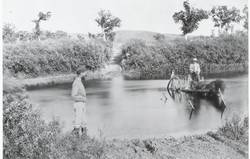Description
Coulter Park is the site of the longest running annual picnic. Ever since 1882 it has been used as a recreational facility.
Story: Sourisford
One of the most important River crossing in the southwest
A River Crossing
Sourisford, as the name suggests, was well known as a convenient place to ford the Souris River. In this place especially, a gravel bottom spans the width of the river and the soft banks on either side were worn down by herds of bison over years of migrations. The banks of this portion of the river was a popular camping place for First Nations and the location of an impermanent village. It was also a camping place for early explorers, the Boundary Commission Surveyors and the North West Mounted Police.

Early Settlers
A group of three men were the first settlers to make their way to the Souris River and build homesteads in 1882. When they arrived, they discovered a man named Charlie West had made the bank of the Souris River his home. Supposedly he had been working for the Hudson’s Bay Company and had fallen out of favour. Nevertheless, he disappeared the next spring.
Arriving from the west on the Boundary Commission Trail, Gould and Elliot built a house and barn at the crossing of the Trail and the river. With the increase of settlement travel westward, their home became established as a regular “stopping place.” Many settlers were relieved to arrive at Gould and Elliot’s where there were warm and comfortable stables and a hot meal served in the house for a very moderate price.
The stopping place slowly grew into a small unofficial community. During the summer of 1882 a store was operated out of a tent by settlers Warren and Snider. A regular post office called “Sourisford” was installed the next year. T. B. Gerry opened a blacksmith shop and F. B. Warren opened a store which operated for two or three years.
Embryo Towns
In 1882 two early settlers, Carbert and Lett, planned a subdivision for “Souris City” on the east side of the Souris River. The town was extensively advertised, with large maps showing a town of 2,088 lots. It was touted as becoming a major manufacturing centre amidst splendid agricultural land and on the banks of a river that could connect to larger centers. In July of 1883, the registrar’s office for the Souris River area moved from Deloraine to the site of Souris City. The registrar, Mr. J. P. Alexander, built his home on the site—the only building that was ever built in Souris City. Though lots were sold to people as far away as the Maritimes, Souris City never took off because of a town downriver (present-day Souris) that was already registered under that name. Souris City, also known as Sourisapolis, was officially canceled as a town plan in 1916.
Oldest Picnic Area in the West
Today, Sourisford is the location of one of the earliest regularly used recreation sites in rural Manitoba. As far back as August 1882, in a beautiful grove near Gould's home, a crowd bigger than any other in southwest Manitoba at that time gathered for a picnic. Since then, picnics have been held in the grove every summer. These gatherings used to attract thousands of locals and visitors alike, many from the United States. Bannock with syrup would be served up, along with a dinner laid out on blankets in true picnic style. Short addresses were sometimes given before a band played to liven things up. In 1903 the event became a combination between track and field activities and a bush picnic. The town of Melita declared the day a holiday so that everyone could attend.
In 1939, Francis Coulter donated the land the picnic was held on and it was designated as Coulter Park. Gould's stone house also remains preserved on the site as a last reminder of the town of Sourisford.
. . . . .
Related Articles:
-
[Gould's House]
. . . . .
Author: Teyana Neufeld, 2013.
Sources:
Campbell, Charles F. Municipality of Arthur and its History. Melita-Arthur Historical Committee. Pages 2-4.
Estlin, A. B. The First Settlers. Melita-Arthur Historical Committee. Pages x-xi.
---. Land Titles Excerpts. Melita-Arthur Historical Committee. Pages 1-2.
“Pioneer Picnic”. Melita-Arthur Historical Committee. Page 194.
Melita-Arthur Historical Committee. Our First Century Melita and Arthur. Altona: Friesen Printers, 1983.
Women’s Institute. Melita’s Tales and Trails. 1879-1967.
